Nest of Salt
19 — 22 January 2023
AMP Gallery, London

Installation view, AMP Gallery. Photo by Jérôme Favre.
“Since Heraclitus, it’s been a commonplace that things are in continuous flux, but alchemical thinking opens a much more radical possibility: that flux itself may be a thing.” — James Elkins, What Painting Is
“So I’ve sat and I’ve watched an ice-age thaw Are you the one that I’ve been waiting for?” — Nick Cave
Transformation lies at the heart of artistic practice. Art is related to artifice, in part meaning workmanship, the creation of something using craft and skill; in part meaning skill in cunning and trickery – the ability to create an impression or illusion of something by the process of transformation. Art is linked to alchemy, the medieval form of chemistry that dealt with the transformation of base materials into gold.
In his essay on the relationship between painting and alchemy, James Elkins breaks down the distinction between the properties of materials and their chemical substances:
“The alchemists debated the nature of qualities; sometimes they thought of them as clothes that could be taken off, leaving the pure ‘body’ of the object, and other times they thought qualities were the body itself… the moral I draw from these debates… is that where alchemy and painting are concerned, there is no reason to distinguish substances, qualities, principles, and even elements. What matters in any specific instance is what is occupying the mind: a certain oil varnish may be engaging because it is unusually viscous, in which case a quality counts as a substance… substances occupy the mind as concepts and concepts occupy the mind as substances.” ibid. pp 108-109 (emphasis added)
In other words, the effects produced by the properties of a substance are, in Elkins’ view, inseparable from the substance itself and constitute its “body”. While painting is an act of transformation, Elkins demonstrates that the point might not be to transform the subject into paint; the point may simply be transformation itself.
Nest of Salt presents work by six artists that all deal, in some part, with themes of transformation, deconstruction and illusion.
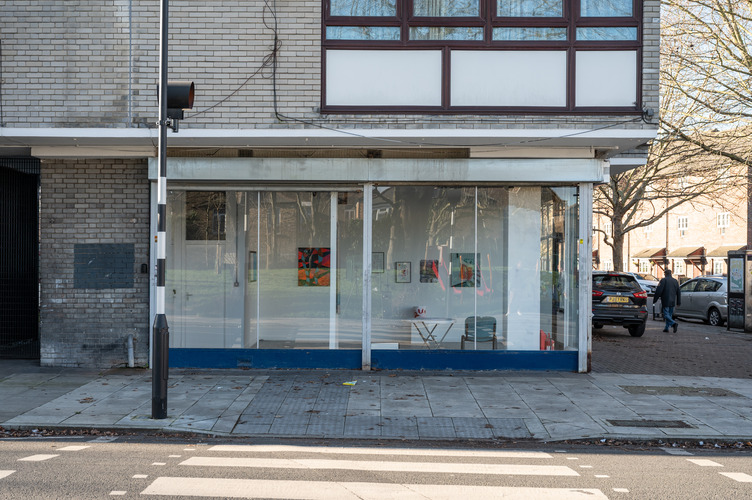
Installation view, AMP Gallery. Photo by Jérôme Favre.
Amanda Houchen studies the relationship between illusionism and abstraction through her paintings. Playing with the spatial properties of painting using division, colour and light, Houchen creates optical illusions in her paintings with the placement of flat geometric shapes, fused with more organic forms and structures.
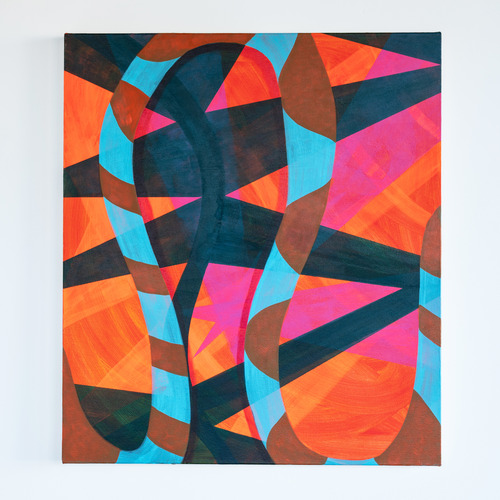
Amanda Houchen, ‘Spaces Inbetween’ (2022). Oil and acrylic on canvas. 80 x 70 cm. Photo by Jérôme Favre.
Tim Ralston’s practice deals with deconstructing painting to its constituent parts. Focusing on the support and surface of painting, Ralston’s frugal approach utilises salvaged and reclaimed materials.

Tim Ralston, ‘Take a Seat’ (2022). Timber and brass fixings. 40 x 45 cm. Photo by Jérôme Favre.
Maggie Williams explores themes of cultural identity and the effects of second-generation diaspora. Considering the fractured, contradictory experience of belonging, Williams uses a wide array of media, from playfully reappropriating found objects to challenging the confines of more traditional techniques such as embroidery. Her process-based work tries to make sense of the liminal space between the two cultures.
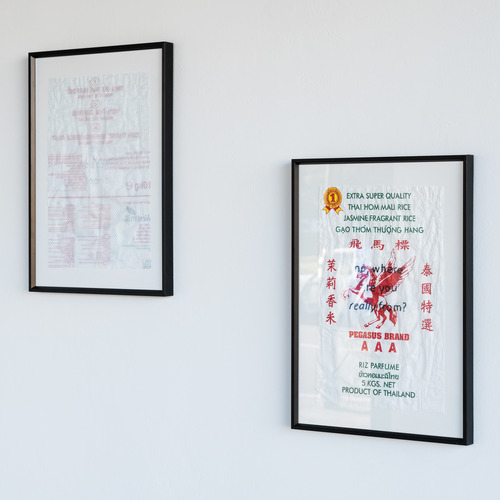
Maggie Williams, ‘No, Where Are You Really From?’ (2022) and ‘Oh… You Don’t Look It’ (2023). Embroidery on rice bag. 43 x 30.5 cm each. Photo by Jérôme Favre.
Richard Graville’s practice focuses on cross-species colour codes crucial to our survival when life is dangerous. Graville has done extensive research into evolutionary biology to understand how we share this colour language. Reducing unnecessary detail to make us more conscious of how our perceptions operate, he builds up his paint surfaces in thin coats of Flashe and acrylic paint. Each element of his paintings is masked resulting in precise edges and raised zones.
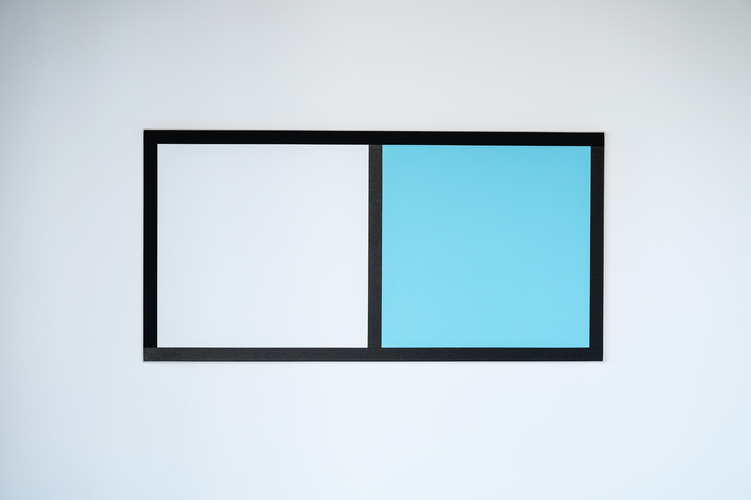
Richard Graville, ‘Eye’ (2022). Flashe and acrylic on canvas. 60 x 120 cm. Photo by Jérôme Favre.
Stephen Buckeridge looks at painting as a process that is constantly being re-negotiated using gestures and marks which suggest liminal spaces where traces of activity sit between absence and presence or something in-between.
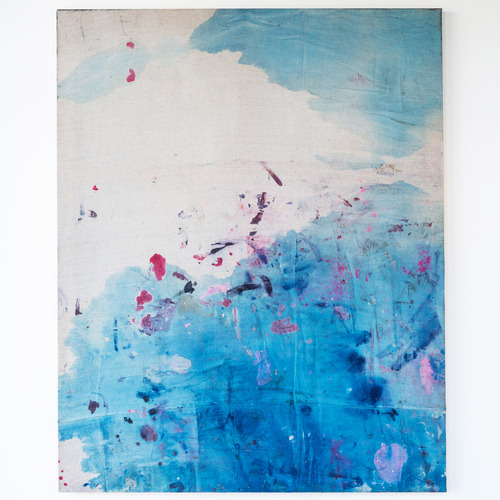
Stephen Buckeridge, ‘Hear the Silence Bittersweet on the Breeze’ (2021-22). Acrylic and pigment on dust sheet. 150 x 120 cm. Photo by Jérôme Favre.
George Chapman deals with urban spaces that have frequently become derelict and imbued with a haunted sense of failure, emptiness, and nostalgia. In his paintings, Chapman uses colours that are emotive and create a subjective impression of the derelict space, as though viewing it from memory or in a dream. In this sense, Chapman’s works are about blight and disintegration, but also about the fine line between the evocative nature of memory and the unsettling feeling that you are permanently estranged from home.

George Chapman, ‘No Name # 2’ (2022). Oil paint and acrylic on canvas. 70 x 60 cm. Photo by Jérôme Favre.
Artist Biographies
Amanda Houchen has recently completed the on-site course at Turps Art School in 2021. She also has a Masters in Fine Art from City and Guilds School for Art, graduating in 2014. Amanda has exhibited at the Royal Academy Summer exhibition, The London Art Fair, as well as group exhibitions including the Turps Leavers Show at Thames-Side Studios Gallery, The Ingram Collection Young Contemporary Talent Purchase Prize and Exceptional at Collyer Bristow.
Instagram: @houchen_amanda
Website: amandahouchen.com
Tim Ralston b. 1982, originally from south London, now lives and works in Lisbon where, alongside his painting practice, he runs a residency project and gallery, PADA Studios. Tim also curates the project Recreational Grounds in London and mentors on the Turps MASS CC programme.
Instagram: @tim.ralston
Website: padastudios.com
Maggie Williams, b. 1989, received a BA (Hons) in Fine Art from the University of Hertfordshire in 2011. She has exhibited in numerous exhibitions across London and the UK, including at Royal Festival Hall, Hackney WickED and The Auction Collective. She was invited to her first solo exhibition in 2014 at cueB Gallery in Brockley, was a finalist for the ArtSlant Prize and Zealous X in 2016, and featured in The Bigger Picture podcast by Arcarta in 2020.
Instagram: @insatiablemagpie
Website: maggie-williams.com
Richard Graville is a painter based on the south coast of the UK. Born in London, he studied at Chelsea School of Art, Goldsmiths College, and Kingston University. He has exhibited extensively including solo shows in London and New York. In 2019 he participated in an arts residency at PADA studios in Lisbon, Portugal. He recently held a solo show ‘We like the taste of certain poisons’ at NoHAWKERS Gallery in Brighton. Later this year he has a solo show at Saturation Point in Deptford, London.
Instagram: @richard_graville
Website: richardgraville.net
Stephen Buckeridge, b. 1961, received a BA (Hons) in Fine Art painting from Falmouth School of Art in 1982 and a MA in Fine Art (painting) theory and practice from Middlesex University in 2005. He has show in group exhibitions widely throughout the UK and Europe, including ‘Difference’ with Patrick Jones and Robin Greenwood at Abcrit.org in 2021, both the BEEP painting prize and the London Group biennial exhibition on two occasions. In 2022 he was selected and exhibited as part of a Generous Space 2 as part of the Artist Support Pledge at The New Art Gallery, Walsall. Since 2021 he has been participating in the Turps Banana Off-site Painting Programme.
Instagram: @stephenbuckeridge
Website: stephenbuckeridge.com
George Chapman, b. 1988, received a BA (Hons) in Fine Art from the Michaelis School of Fine Art in Cape Town in 2010 and recently completed the Turps Banana Off-site Painting Programme between 2020-21. He has shown in group exhibitions in South Africa, the UK, and Portugal, including at Thames-side Studios Gallery, Norval Foundation, and PADA Studios. In 2017, he held a solo exhibition at Art Hub Studios Gallery in Deptford, and in 2021 he held a joint exhibition with Will Thorburn at Space Gallery in Folkestone. In 2019, he participated in the PADA Studios residency programme in Lisbon. In March 2022 he curated his first group exhibition, Badlands, at no format Gallery in Deptford.
Instagram: @gn.chapman
Website: georgechapman.studio
—